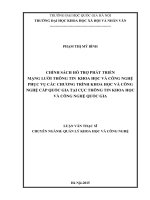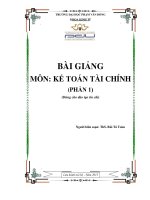tài liệu tiếng anh chuyên ngành quản trị kinh doanh English2
Bạn đang xem bản rút gọn của tài liệu. Xem và tải ngay bản đầy đủ của tài liệu tại đây (274.65 KB, 7 trang )
Unit 1: Economic activity
- Who is that person that you must respect? (Người ấy là ai mà anh phải kính trọng?)
- What is this that worries you so? (Đó là việc gì mà làm anh lo lắng đến thế?)
h. That dùng sau lần mở đầu bằng It is, It was
- It is the teacher that is imporant, not the kind of school he teaches in. (chính thầy giáo
mới quan trọng, chứ không phải trường mà thầy giáo dạy.)
- Was it you that broke the window? (Có phải anh đã làm vỡ cửa sổ không?)
Sau khi bạn đã đọc kỹ phần cấu trúc 1, bạn hãy làm các bài tập sau đây:
Exercise 1
Combine these pairs of sentences as in the example ( Bạn hãy nối 2 câu thành một câu có sử
dụng đại từ quan hệ which theo như ví dụ mẫu.)
Example: The services are useful. The workers provide services.
The services which the workers provide are useful.
a. The goods are essential. They need the goods.
………………………………………………………………………………………………
b. The schools and hospitals are essential. They provide schools and hospitals.
………………………………………………………………………………………………
c. The goods are valuable. He buys the goods.
………………………………………………………………………………………………
d. The money buys essential commodities. People can earn this money.
………………………………………………………………………………………………
e. The goods and services are very useful. People produce these goods and services.
………………………………………………………………………………………………
f. The work is called economic activity. We do this work.
………………………………………………………………………………………………
g. The work provides them with money. People do this work.
………………………………………………………………………………………………
h. The economic activities make up the economic system. People undertake these economic
activities.
………………………………………………………………………………………………
Exercise 2: Viết lại câu sử dụng các đại từ quan hệ who, which, that
9
Unit 1: Economic activity
a. I saw the man. He closed the door.
………………………………………………………………………………………………
b. The girl is happy. She won the race.
………………………………………………………………………………………………
c. The student is from China. He sits next to me.
………………………………………………………………………………………………
d. The students are from China. They sit in the front row.
………………………………………………………………………………………………
e. We are studying sentences. They contain adjective clauses.
………………………………………………………………………………………………
f. I am using a sentence. It contains an adjective clause.
………………………………………………………………………………………………
g. Algebra problems contain letters. They stand for unknowm numbers.
………………………………………………………………………………………………
h. The taxi driver was friendly. He took me to the airport.
………………………………………………………………………………………………
Exercise 3: Viết lại các câu sau sử dụng đại từ quan hệ whose
a. I apologized to the woman. I spilled her coffee.
………………………………………………………………………………………………
b. The man called the police. His wallet was stolen.
………………………………………………………………………………………………
c. I met the woman. Her husband is the president of the corporation.
………………………………………………………………………………………………
d. The professor is excellent. I am taking her course.
………………………………………………………………………………………………
e. Mr. North teaches a class for students. Their native language is not English.
………………………………………………………………………………………………
f. I come from a country. Its history goes back thousands of years.
………………………………………………………………………………………………
g. The people were nice. We visited their house.
10
Unit 1: Economic activity
………………………………………………………………………………………………
h. I live in a dormitory. Its residents come from many countries.
………………………………………………………………………………………………
i.
I have to call the man. I accidently picked up his umbrella after the meeting.
………………………………………………………………………………………………
j.
The man poured a glass of water on his face. His beard caught on fire when he lit a
cigarrette.
………………………………………………………………………………………………
Structure 2: Change nouns into adjectives (Chuyển danh từ sang tính từ)
Để chuyển từ danh từ sang tính từ, bạn có thể thêm các hậu tố khác nhau như: al, ly…. Trong
bài 1, bạn học cách thêm hậu tố “al” vào sau danh từ để được một tính từ mới.
Ví du:
condition (danh từ) + al (hậu tố) → conditional (tính từ)
form (danh từ) + al (hậu tố) → formal (tính từ)
Bây giờ bạn hãy làm bài tập số 1.
Exercise 1
Bạn hãy chuyển các danh từ được in nghiêng trong các câu sau thành tính từ để điền
vào các ô trống.
Example:
education → education + al → educational
Commerce → commerci + al → commercial
a. These goods belong to the nation. They are therefore ________.
b. Minerals are a part of nature. They are therefore ________.
c. Schools provide education. They are therefore centers of ______ activity.
d. Shops are places of commerce. They are therefore centers of ______ activity.
e. He does not want anyone else to do this work. He wants to do the work in person. It is his
_______ concern.
3. TEXT 1.2
Bạn hãy đọc bài đọc 2 thật cẩn thận, sau đó làm bài tập số 1 và số 2 dưới đây:
Most people work to earn a living, and produce goods and services. Goods are either
agricultural (like maize and milk) or manufactured (like cars and paper). Services are such things
as education, medicine and commerce. Some people provide goods; some provide services. Other
people provide both goods and services. For example, in the same garage a man may buy a car or
some service which helps him to maintain his car.
11
Unit 1: Economic activity
The work which people do is called economic activity. All economic activities together
make up the economic system of a town, a city, a country or the world. Such an economic system
is the sum-total of what people do and what people want. The work people undertake either
provides what people need or provides the money with which they can buy essential commodities.
Of course, most people hope to earn enough money to buy commodities and services which are
non-essential but provide some particular personal satisfaction, like toys for children, visits to the
cinema.
Exercise 1
Trong bài tập này có 10 câu, bạn hãy quyết định xem câu nào đúng, câu nào sai và sửa lại
câu sai cho đúng.
1. Most people produce either goods or services.
…………………………………………………………………………………………………
2. Services are either agricultural or manufactured.
…………………………………………………………………………………………………
3. Education and medicine are provided by schools and hospitals.
…………………………………………………………………………………………………
4. Cars and paper are agricultural goods.
…………………………………………………………………………………………………
5. Paper is non- agricultural commodity.
…………………………………………………………………………………………………
6. The work which people do is called an economic system.
…………………………………………………………………………………………………
7. A city has its own economic system.
…………………………………………………………………………………………………
8. Economic activity is the sum-total of what people do and want.
…………………………………………………………………………………………………
9. The work people undertake provides them with money, or with what they need.
…………………………………………………………………………………………………
10. Most people do not want to buy non-essential commodities and services.
…………………………………………………………………………………………………
Exercise 2
Trong bài tập số 2, bạn sẽ làm bài luyện thêm với các đại từ which và that. Bạn hãy thay thế
các đại từ which bằng đại từ that trong các câu sau. Sau đó, bạn viết lại các câu đó mà không sử
12
Unit 1: Economic activity
dụng cả hai đại từ which và that. (Lưu ý thêm: khi câu bạn viết lại không có các đại từ quan hệ
which và that thì ý nghĩa của câu vẫn giữ nguyên nhưng câu viết kém phần trịnh trọng hơn).
2.1:
a. The goods which they wanted were essential minerals.
………………………………………………………………………………………………
b. The schools and hospitals which they provide are essential.
………………………………………………………………………………………………
c. The goods which he buys are valuable.
………………………………………………………………………………………………
d. The money which the people earned bought many commodities.
………………………………………………………………………………………………
e. The goods and services which people produce are very useful.
………………………………………………………………………………………………
f. The work which we all do is called economic activity.
………………………………………………………………………………………………
g. The work which most people do provides them with money.
………………………………………………………………………………………………
h. The economic activities which people undertake make up the economic system of a town,
city, country or a larger area.
………………………………………………………………………………………………
i.
The economic system which people belong to is the sum-total of their needs and actions.
………………………………………………………………………………………………
j.
The work which he undertook was useful but non-essential.
………………………………………………………………………………………………
2.2:
a. The goods which they wanted were essential minerals.
………………………………………………………………………………………………
b. The schools and hospitals which they provide are essential.
………………………………………………………………………………………………
c. The goods which he buys are valuable.
………………………………………………………………………………………………
d. The money which the people earned bought many commodities.
13
Unit 1: Economic activity
………………………………………………………………………………………………
e. The goods and services which people produce are very useful.
………………………………………………………………………………………………
f. The work which we all do is called economic activity.
………………………………………………………………………………………………
g. The work which most people do provides them with money.
………………………………………………………………………………………………
h. The economic activities which people undertake make up the economic system of a town,
city, country or a larger area.
………………………………………………………………………………………………
i.
The economic system which people belong to is the sum-total of their needs and actions.
………………………………………………………………………………………………
j.
The work which he undertook was useful but non-essential.
………………………………………………………………………………………………
Exercise 3: Dịch bài đọc 2 sang tiếng Việt. Nếu gặp từ mới nào mà bạn còn chưa rõ nghĩa
thì hãy tra lại từ trong phần Vocabulary.
4. LISTENING: Introducing Transworld
Ann Bell làm việc cho văn phòng Transworld Freight ở Manchester. Cô ấy đang nói
chuyện với một nhân viên mới ở trong căng tin (Anne Bell works in the Manchester office of
Transworld Freight. She is in the canteen talking to a new employee).
Exercise 1: Listening comprehension
Bạn nghe qua đĩa một lần và hãy quyết định xem ai làm gì (Listen to the disc once through.
Then look at these lists and see if you can remember which person at Transworld did what.)
1. Anne Bell
a. She did the photocopying.
2. Sandra Parr
b. He ate a sandwich.
3. David Thompson
c. He arranged exports.
4. Liz Shepherd
d. She did the filling.
5. Nick Dawson
e. He spent time at the docks and the airport.
6. Kevin Hughes
f. She took shorthand and typed letters.
7. Jane Long
g. She worked in the accounts department.
h. She introduced David to Sandra.
14
Unit 1: Economic activity
i.
He drank a cup of coffee.
j.
He sat at a table.
k. She welcomed David to Transworld.
l.
He sent customers their bills.
m. He worked with the customs officials.
n. He talked to Jane.
o. She handled airfreight.
p. He dealt with customers’ accounts.
Now say the past tense of these regular and irregular verbs like this:
Laboratory
P: Do
R: Did
Exercise 2: Present simple and present progressive
Write and read your answers to Exercise 1 in the present, like this:
P: What does Anne do?
R: She takes shorthand.
P: What else does she do?
R: She types letters.
P: What’s Nick doing in the picture?
R: He’s sitting at a table.
P: What else is he doing?
R: He's eating a sandwich.
Laboratory drill A
P: Nick’s sitting at a table.
R: Oh? What’s he doing exactly?
He’s typing a letter.
P: Sandra works in reception.
R: Oh? What does she do exactly?
Laboratory drill B
P: She handled airfreight.
R: She handles airfreight.
Laboratory drill C
P: He sat at a table.
R: At the moment he’s sitting at a table.
15









